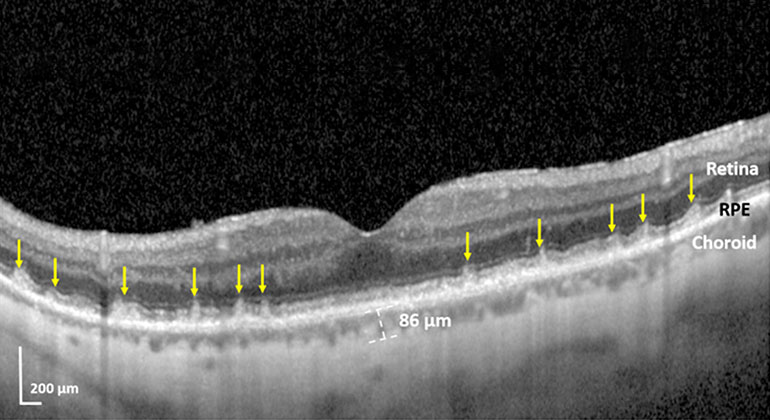Eye Damage Linked to Popular Over-the-Counter Vitamin That Lowers Cholesterol Can Be Reversed
Study is the first to identify specific cellular toxicity and show improvement after stopping supplement use
In a first-of-its-kind clinical report, retina specialists at the New York Eye and Ear Infirmary of Mount Sinai (NYEE) have shown that severe vision loss from a self-prescribed high dose of over-the-counter niacin is linked to injury of a specific cell type in a patient’s eye. The experts report that discontinuing the vitamin led to reversal of the condition and have published their findings in the fall issue of Journal of VitreoRetinal Diseases.
Niacin, also known as vitamin B3, is used for lowering hyperlipidemia or cholesterol and comes in prescription and over-the-counter forms; it can produce a rare toxic reaction called niacin-induced cystoid maculopathy, a form of retinal swelling.
“People often live by the philosophy that if a little bit is good, more should be better. This study shows how dangerous large doses of a commonly used over-the-counter medication can be,” said lead investigator Richard Rosen, MD, Chief of Retina Services at NYEE and the Mount Sinai Health System. “People who depend on vision for their livelihood need to realize there could be long-lasting consequences from inadvertent overdosing on this vitamin.”
“This case serves to remind everyone about the importance of talking to one’s physician prior to taking any supplement, or over-the-counter product. Just because nutritional supplements are available without prescription does not mean they are completely safe to use without supervision,” explains corresponding author Jessica Lee, MD, Assistant Professor of Ophthalmology at the Icahn School of Medicine at Mount Sinai. “No matter how benign a supplement or over-the-counter product may seem, the correct dosage and potential interactions with other medications should be carefully reviewed with a doctor, to avoid preventable unexpected consequences. This case illustrates how dangerous casual self-prescribing of megadoses of vitamins can be.”
The team of investigators from NYEE reported on a 61-year-old patient who arrived at the hospital with worsening blurry vision in both eyes that began a month earlier. The initial exam showed that the patient was almost legally blind, with best-corrected visual acuity of 20/150 in the right eye and 20/100 in the left eye. The patient told doctors his medical history included significant hypertension and hyperlipidemia, but initially failed to disclose the extent of his self-prescribing. Subsequently, he admitted to taking an extensive list of supplements, which included three to six grams of niacin daily for several months to reduce his risk of cardiovascular events and was unaware of the risk to his eyesight. He purchased the supplement at a drug store after a doctor told him he had high cholesterol. The standard dosage is one to three grams a day with a maximum dose of six grams, but doctors typically warn against treating the condition with supplements purchased over the counter and prefer to prescribe and monitor an FDA-approved dose of niacin.
NYEE clinicians diagnosed the problem using several state-of-the-art technologies, including fluorescein angiography, optical coherence tomography (OCT), and multifocal electroretinography (MERG), to examine his retina for evidence of cellular damage and monitor his response to therapy. Fluorescein angiography uses fluorescent dye to trace blood flow through retinal arteries and veins, looking for leaks. OCT is an advanced structural imaging technique that reveals the cross-sectional details of the retina cells, layer by layer. MERG measures the electrical signals from different layers of cells in the eyes.
The imaging allowed investigators to diagnose a rare toxic reaction called niacin-induced maculopathy. The high dose of niacin led to cystoid macular edema of the retina, which is fluid in the macula (a small area in the center of the retina that produces detailed and centralized vision) that causes swelling. The technology also allowed investigators to identify the cellular structures responsible for the patient’s condition. The MERG recorded in this case showed reduced b-waves, which indicated that cells affected by the toxicity were the Muller cells, which span the depth of the retina like support columns. Discontinuation of the vitamin reversed this effect and restored retinal function and electrical signals. This led investigators to demonstrate, for the first time, that the Muller cells were the target of niacin toxicity, and the cause of niacin maculopathy.
Ophthalmologists from NYEE explained the situation to the patient and advised him to stop taking the over-the-counter niacin immediately. At his one-week follow-up appointment, his vision had noticeably improved. Two months later, the dysfunction had completely resolved and his vision was back to 20/20. Through the high-tech structural and metabolic imaging, researchers observed that the patient’s Muller cells had gradually yet dramatically recovered.
“While retina specialists have been aware of this unusual reaction to niacin for many years, such a textbook example of extreme toxicity and recovery has never been as well documented by imaging and functional testing,” said Dr. Rosen.
“In this instance the patient was particularly fortunate that the physicians who saw him were alert to the possible cause and were able to confirm their diagnostic suspicions with appropriate testing. This may not always be the case and other patients may not have such a successful outcome,” added Dr. Lee.
About the Mount Sinai Health System
Mount Sinai Health System is one of the largest academic medical systems in the New York metro area, with 48,000 employees working across seven hospitals, more than 400 outpatient practices, more than 600 research and clinical labs, a school of nursing, and a leading school of medicine and graduate education. Mount Sinai advances health for all people, everywhere, by taking on the most complex health care challenges of our time—discovering and applying new scientific learning and knowledge; developing safer, more effective treatments; educating the next generation of medical leaders and innovators; and supporting local communities by delivering high-quality care to all who need it.
Through the integration of its hospitals, labs, and schools, Mount Sinai offers comprehensive health care solutions from birth through geriatrics, leveraging innovative approaches such as artificial intelligence and informatics while keeping patients’ medical and emotional needs at the center of all treatment. The Health System includes approximately 9,000 primary and specialty care physicians and 10 free-standing joint-venture centers throughout the five boroughs of New York City, Westchester, Long Island, and Florida. Hospitals within the System are consistently ranked by Newsweek’s® “The World’s Best Smart Hospitals, Best in State Hospitals, World Best Hospitals and Best Specialty Hospitals” and by U.S. News & World Report's® “Best Hospitals” and “Best Children’s Hospitals.” The Mount Sinai Hospital is on the U.S. News & World Report® “Best Hospitals” Honor Roll for 2025-2026.
For more information, visit https://www.mountsinai.org or find Mount Sinai on Facebook, Instagram, LinkedIn, X, and YouTube.

Blinding Eye Disease Strongly Associated With Serious Forms of Cardiovascular Disease
Nov 17, 2022 View All Press Releases
High-Tech Imaging Offers New Way to Detect Signs of Early Glaucoma
Aug 02, 2022 View All Press Releases
Blinding Eye Disease Is Strongly Associated With Heart Disease and Stroke
Jul 12, 2022 View All Press ReleasesThree Mount Sinai Ophthalmologists Receive Prestigious Achievement Awards
Dec 01, 2020 View All Press ReleasesBreakthrough Technology Used to Discover Eye Damage from Repeated Intravitreal Injections
Apr 13, 2020 View All Press Releases